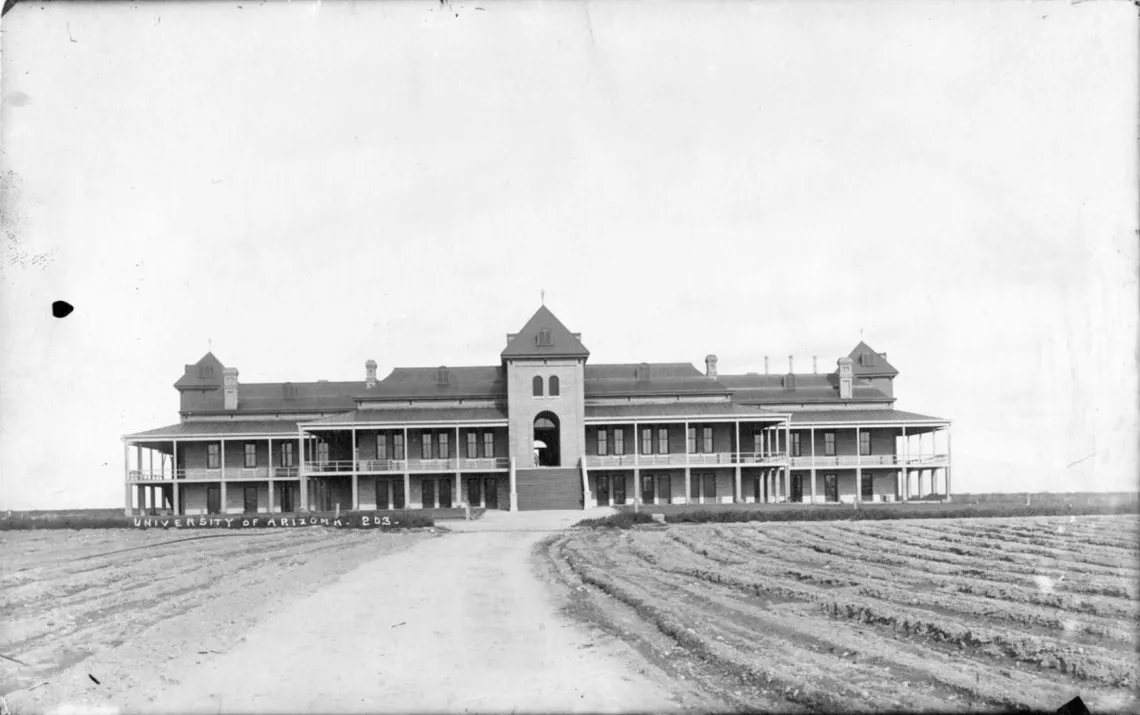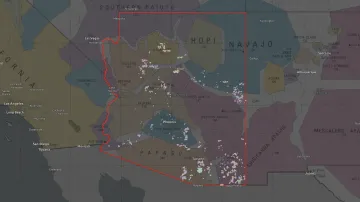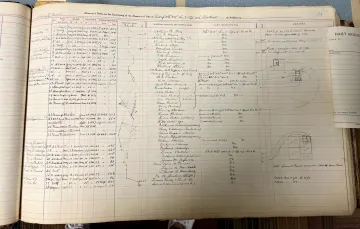Project examines, maps UArizona land-grant history
The University of Arizona Land-Grant Project website is a resource for researchers and the public to better understand the university's land-grant designation and its impact on Indigenous people in Arizona.

The University of Arizona's designation as a land-grant institution has long been central to its identity and mission, signifying the university's commitment to education, research and outreach that directly serves the state and residents of Arizona.
A new website, called the University of Arizona Land-Grant Project, aims to document the story of the land-grant status and the designation's impact on Indigenous peoples in Arizona. The recently launched website was researched and built by a team from the Daniel F. Cracchiolo Law Library in the James E. Rogers College of Law.

The project details the 19th-century federal legislation that led to the university's land-grant designation, the forced removal and relocation of Indigenous tribes in Arizona when it was a territory, and the university's founding in 1885. It also includes a nearly complete accounting and mapping of the acres of land the federal government provided to the state on behalf of the university in accordance with its land-grant designation.

The project can provide researchers, the university community and the general public a better understanding of what it means for the university to be a land-grant institution, said Teresa Miguel-Stearns, director of the law library and a professor of law who led the research behind the project.
"We wanted the entire community to be able to benefit from this resource," said Miguel-Stearns, who is also associate dean of legal information innovation in the College of Law. "This website was written and designed so that everyone could access and learn from it."

Following media and public interest about the history of America's land-grant universities, the project originated with a request from several tribal leaders at the UArizona's 2021 Tribal Leaders Summit, said Levi Esquerra, UArizona senior vice president for Native American advancement and tribal engagement.
The university's main campus resides on the homelands of the O'odham, as well as the Yaqui. The university has committed to building sustainable relationships with Arizona's tribes through education offerings, partnerships, and community service.
The University of California, Davis earlier this year examined actions land-grant universities have taken to address their histories. In that project's final report, released in June, researchers noted that the University of Arizona was among just three universities that had "by far" offered "the most support and programs for Native students and/or for local tribes."
The UC Davis report cited the university's Arizona Native Scholars Grant, which covers tuition and mandatory fees for full-time undergraduate students from Arizona's 22 federally recognized tribes who are studying on the main campus; Esquerra's role as the university's tribal relations leader; and the publication of the Land-Grant Project.
The Land-Grant Project sought to conduct in-depth research to provide an accurate, detailed analysis of the university's land-grant history.
"This is an example of us taking time to listen to tribes, trying to get a better understanding, and then acting upon what we hear," said Esquerra, who also sits on the tribal council for the Chemehuevi Indian Tribe, whose reservation is located along the Colorado River in California. "Now we need to use this website. I know it can be a jumping-off point for additional research."
Robert A. Williams Jr., a Regents Professor of Law and faculty chair of the Indigenous Peoples Law and Policy Program, was also involved in the early planning of the project and helped usher the request to Miguel-Stearns and her team.
"Our library team did an amazing job in providing the most complete and accurate accounting that's ever been rendered in acres, dollars and cents on how the University of Arizona has benefitted from the lands that were taken by the federal government over the course of the past century-and-a-half," said Williams, who is a member of the Lumbee Tribe of North Carolina.
Understanding 19th-century Arizona
The website's historical narrative begins with the decades leading up to 1863, the year Arizona was designated a U.S. territory.
Miguel-Stearns – with the help of Kristen Keck, a library services associate in the law library, and Samantha Ginsburg, a law library fellow and graduate assistant – used primary sources from University Libraries' Special Collections, the National Archives, legal and historical databases, and other entities to piece together several chapters of Arizona history.

Those chapters included the founding of Arizona Territory and a timeline detailing how the U.S. government forcibly removed Indigenous people from the region during the second half of the 19th century.
"That, to me, is one of the primary accomplishments of this project – being able to piece together, recognize and legitimately document the history of the displacement and relegation of Arizona's Native nations," Miguel-Stearns said.
Other sections of the site cover the founding of the university and how it received its land-grant designation.
That began with the Morrill Act of 1862, which allowed states to establish land-grant universities. Sponsored by Vermont Sen. Justin Morrill, the law granted states 30,000 acres of land for every Congressional representative each state had. Though most states were granted land within their state lines, many – especially those in the eastern U.S. – were granted acreage, which was called scrip, in the western U.S. Pennsylvania and Alabama, for example, were granted scrip in Arizona, which was sold to benefit Penn State and Auburn University, respectively.
The states could then sell or lease the land, or lease use rights to it, for purposes such as for ranching or mining. The proceeds from these sales or leases would allow the states to establish endowments for universities, which would focus in particular on agricultural and mechanical education.
The 1862 law came a year before Arizona became a territory, long before the university was established in 1885 and opened its doors to the first class of students in 1891. Because of this timing, Miguel-Stearns said, the state did not directly receive land on behalf of the university from the 1862 Morrill Act.
But an act of Congress in 1881 granted 46,000 acres of public land to the territory of Arizona for the university's benefit. Then, in 1910, through Arizona's Enabling Act, which established Arizona's statehood, Congress gave the state 2.3 million acres of public land, including 800,000 acres on behalf of the University of Arizona per its land-grant status.
"We wanted to dig into the history to give us the context for understanding the land, the university, and the people who were involved in the university's founding," Miguel-Stearns said.
Data designed to empower
Most of the chapters on the project website include interactive maps, giving readers a visual guide alongside the written history.
On one map, visitors can see where Indigenous peoples held territory before colonization. Users can drag a slider from the right side of the map to the left, revealing where the reservations were established after settler colonization. Another map shows the parcels of land that the state accumulated on behalf of the university per its land-grant designation. Dragging the slider overlays the pre-colonial tribal territories on top of the mapped parcels.

Cas Laskowski, the law library's head of research, data and instruction, led the project's map-building efforts, relying on 19th-century maps for tribal territories and data from the U.S. Bureau of Land Management and the Arizona State Land Department to track down the parcels.
Of the roughly 846,000 acres of land the state received from the federal government on behalf of the University of Arizona in accordance with its land-grant status, Laskowski and her team have mapped about 775,000. They plan to keep finding and mapping more.
"What we've done is basically centralized and facilitated the use of this data," Laskowski said. "I want it to be empowering for any communities that need it to be able to tell their own stories, understand their own stories and build on other projects."
The project is a work in progress, Miguel-Stearns and Laskowski said. Looking ahead, the team plans to continue researching and documenting how the university's land-grant status continues to enrich the university, particularly through historical land acquisition and monetary disbursements.
But they also hope tribal leaders and the university's Native faculty and students share their ideas for future phases of the project, Miguel-Stearns said. Visitors to the website who wish to reach out with questions or suggestions or to request data from the project, can email circulation@law-arizona.libanswers.com.
"I don't know how you could read this and not gather value from it and move forward," Esquerra said. "Hopefully, it gives us all a better understanding of the university system, tribal nations and the state of Arizona."
